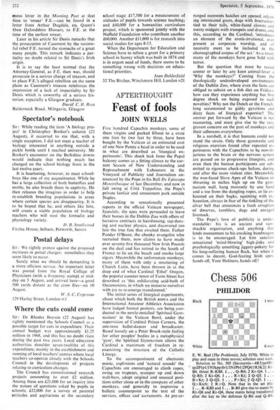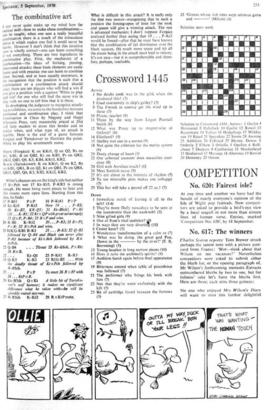Chess 506
PHILIDOR
E. W. Beal (The Problemist, July 1970). White to play and mate in three moves; solution next week. Solution to No. 505 (Savournin-4R3/pp4111/ qp2P1p1/1N3kpp/6r1/3NIPb1/2PQ4/11131(2): Kt-
B4, threat R-1(138. 1 Q-R6; 2 Kt-Q4. 1 . . • Q-R8; 2 Kt-Q6. 1 . . . R x Kt; 2 Q-Q5. 1 . • • B x Kt; 2 Q-Q3. 1 . . . PxKt; 2 Q-Q5. 1 . . . Q xKtch; 2 R x Q. Note that in the set play 1 R-KB5 and 1 ... B-B5 give rise to mates by Kt-Q6 and Kt-Q4, these mates being transferred after the key to the defences Q-R6 and Q-R8.
The combinative art
1 can never quite make up my mind how far tactical skill—how to make chess combinations— can be taught; when one sees a really beautiful combination there is a touch of the miraculous about it which makes one feel it could never be learnt. However I don't think that this intuitive ew is wholly correct—one can learn something if not everything. There are two ingredients in combinative play. First, the mechanics of a combination—the ideas of forking, pinning, discovered attacks; these basic elements are easily learnt and with practice one can learn to combine them. Second, and at least equally important, is the recognition that the position is such that a combination or a combinative attack should exist; there are ten players who will find a win if ou give a position with a caption 'White to play and win' for one who will find the same win in play with no one to tell him that it is there. In developing the judgment to recognise attack- ing possibilities, we come to the borderline between positional and combination play. I think that Combination in Chess by Negyesy and Hegyi (Clematis Press, very reasonably priced at 25s) sill help readers to cross this border and to realise when, and what type of, an attack is feasible. Here is the end of a game between Forgacs and Tartakower to illustrate the point. White to play his seventeenth move.
Winn. (Forgics): K on KKtl, Q on Q2, Rs on KI, KB1, B on QB2. Kt on KB3, Ps on QRZ QKt2, QB3, Q4, K5, KB4, KKt3, KR2.
BLACK (Tartakower): K on KKtl, Q on K2, Rs on KB1, QR1, B on Q2, Kt on QB3, Ps on QR4, QKt5, QB5, Q4, K3, KB2, KKO, KR2.
White's chances are on the king's side but neither 17 BxPch nor 17 Kt-Kt5, P-KR3 is strong enough. He must bring more pieces to bear and this means more open lines. Starting from this idea, he finds: 17P-B51 PxP 18 P-Kt4l PxP
19 Kt-Kt5 P-Kt3 Now 19 . . . P-R3; 20 Kt-R7, KR-Q1; 21 Kt-B6chl, P x Kt (21. . K-RI ; 22 Kt x QP with great advantage); 22 QxP, P-B4; 23 BxP and wins.
20 R-B6 K-Kt2 20 ...P-R3; 21 B x PI, P x B; 22 RxPch and wins.
21 R(K1)-KB1 B-K1 21 . B-K3; 22 Q-B2 followed by Q-R4 and Black can never play P-R3 because of Kt xBch followed by R X 22 Q-B4 . . Threat 25 Kt-K6ch, P xKtr 26 RxR.
22 . . . Kt-Q1 23 P-K61 R-R3
24 Q-K5 K-R3 25 R(1)-B5 ... With
the deadly threat of Kt xPch followed by R-R5ch.
25.., PxP To meet 26 Rx127 with 26 . . . KtPx R.
26 Kt-B7ch Q x Kt A little bit of Tartako- wer's wry* humour; it makes no significant difference what he takes with--he will be .speedily mated anyway.
27 R-R5ch K-Kt2 28 R x KtP mate.
What is difficult in this attack? It is really only the first two moves—recognising that in such a position the foning-open of lines for the rook and queen will give a winning attack. The rest is advanced mechanics; I don't suppose Forgics analysed further than seeing that 19 ... P-Kt3 would be forced—after that he must have known that the combination of (a) dominance over the black squares, (b) much more space and (c) all the pieces being in the attack must lead to victory. It's not easy—but it is comprehensible and there- fore, perhaps, teachable.































 Previous page
Previous page